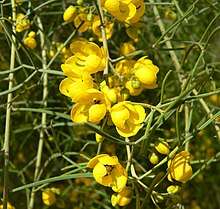Senna artemisioides
Senna artemisioides, the wormwood senna,[1] is a species of flowering plant in the pea family Fabaceae. It is endemic to Australia, where it is found in all mainland states and territories. Other common names include silver senna,[2] silver cassia or feathery cassia - although "cassia" generally refers to the largest-growing Cassiinae. Some of its distinct subspecies also have common names of their own.
| Senna artemisioides | |
|---|---|
 | |
| Senna artemisioides subsp. quadrifolia | |
| Scientific classification | |
| Kingdom: | Plantae |
| Clade: | Tracheophytes |
| Clade: | Angiosperms |
| Clade: | Eudicots |
| Clade: | Rosids |
| Order: | Fabales |
| Family: | Fabaceae |
| Genus: | Senna |
| Species: | S. artemisioides |
| Binomial name | |
| Senna artemisioides (Gaudich. ex DC.) Randell | |
| Synonyms | |
|
Cassia artemisioides Gaudich. ex DC. | |

The Latin specific epithet artemisioides means “resembling Artemisia”, a different group of plants often known as wormwood.[3]
Description
This is an evergreen shrub that grows up to 3 m (9.8 ft) in height. It has grey-green pinnate leaves with between 1 and 8 pairs of leaflets. It produces an abundance of yellow “pea” flowers in winter and spring which are about 1.5 cm in diameter, followed by 2 to 7 cm long flat green pods which age to dark brown.
The species adapts to a wide range of climatic conditions, but is susceptible to frost, especially when young. It prefers dry, well-drained sites with full sun. As an ornamental plant, it is propagated readily from seed, which should first be briefly immersed in boiling water.[4]
This plant has gained the Royal Horticultural Society's Award of Garden Merit.[1][5]
Taxonomy and systematics
The species was first described in 1825 by Charles Gaudichaud-Beaupré based on work by Augustin Pyramus de Candolle and placed in Cassia, but nowadays it has been moved to Senna. However, for a long time this plant was erroneously known as Cassia eremophila which is a true species of Cassia called desert cassia, described by Julius Rudolph Theodor Vogel.
A large number of formerly independent species are provisionally considered subspecies of S. artemisioides:
- ssp. alicia Randell
- ssp. artemisioides
- ssp. filifolia Randell
- ssp. helmsii (Symon) Randell – blunt-leaved cassia
- ssp. oligophylla (F.Muell.) Randell – blunt-leaved cassia
- ssp. petiolaris Randell woody cassia
- ssp. quadrifolia Randell
- (Senna quadrifolia Burm. is a synonym of Chamaecrista absus)
- ssp. sturtii (R.Br.) Randell – Sturt's cassia[6]
- ssp. zygophylla (Benth.) Randell
Some hybridogenic subspecies have also been named:
- nothosubsp. × artemisioides [7]
- ssp. × coriacea (Benth.) Randell[8]
- nothosubsp. × coriacea (Benth.) Randell[9]
- (Cassia coriacea Benth. is a synonym of Chamaecrista coriacea)
- nothosubsp. × sturtii (R.Br.) Randell[10]
In addition, there are apparently at least 2 undescribed taxa:
- Senna artemisioides "James Range (P.L.Latz 18528)"
- Senna artemisioides "Kuyunba (B.Pitts 113)"
Altogether, S. artemisioides might be best considered a form taxon whose phylogenetic diversity is still largely unresolved.
References
- "RHS Plant Selector - Senna artemisioides". Retrieved 4 July 2013.
- "Senna artemisioides". Natural Resources Conservation Service PLANTS Database. USDA. Retrieved 10 November 2015.
- Harrison, Lorraine (2012). RHS Latin for Gardeners. United Kingdom: Mitchell Beazley. ISBN 184533731X.
- "Senna artemisoides". Association of Societies for Growing Australian Plants (ASGAP). Retrieved 2007-12-22.
- "AGM Plants - Ornamental" (PDF). Royal Horticultural Society. July 2017. p. 96. Retrieved 10 November 2018.
- "Cassia sturtii R.Br". PLANTS Database. United States Department of Agriculture. Retrieved 2007-12-22.
- "Senna artemisioides (Gaudich. ex DC.) Randell nothosubsp. × artemisioides". Centre for Plant Biodiversity Research, Australian Government, Canberra. Retrieved 2007-12-22.
- "Senna artemisioides subsp. × coriacea (Benth.) Randell". Centre for Plant Biodiversity Research, Australian Government, Canberra. Retrieved 2007-12-22.
- "Senna artemisioides nothosubsp. × coriacea (Benth.) Randell". Centre for Plant Biodiversity Research, Australian Government, Canberra. Retrieved 2007-12-22.
- "Senna artemisioides nothosubsp. × sturtii (R.Br.) Randell". Centre for Plant Biodiversity Research, Australian Government, Canberra. Retrieved 2007-12-22.
Further reading
- "Senna artemisioides (Gaudich. ex DC.) Randell". Australian Plant Name Index (APNI), IBIS database. Centre for Plant Biodiversity Research, Australian Government.
- "Senna artemisioides". FloraBase. Western Australian Government Department of Parks and Wildlife.
- Association of Societies for Growing Australian Plants (ASGAP): Senna artemisioides
External links
| Wikimedia Commons has media related to Senna artemisioides. |